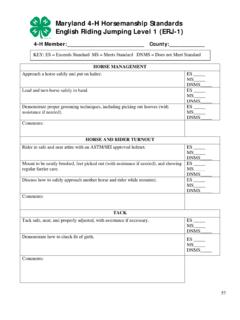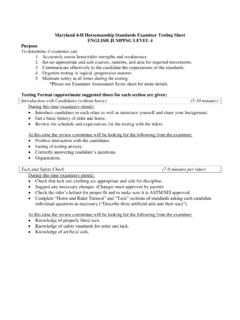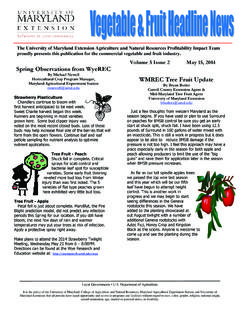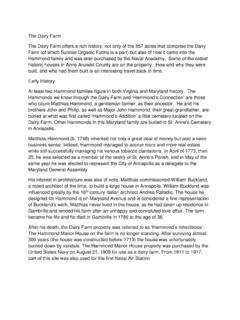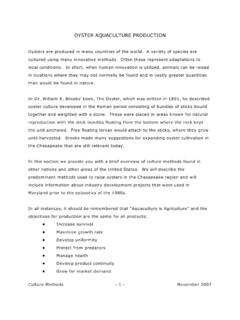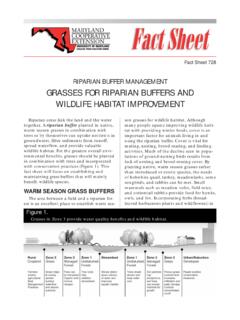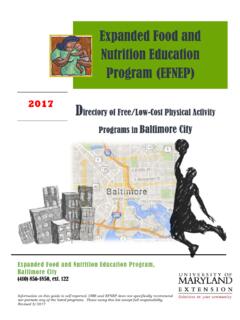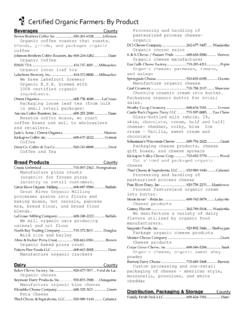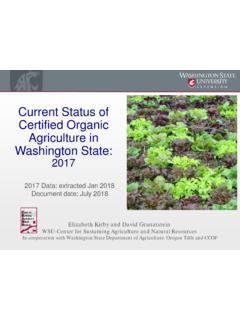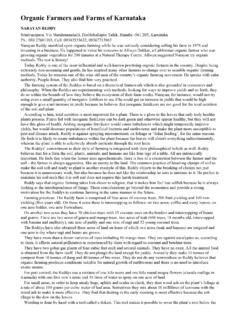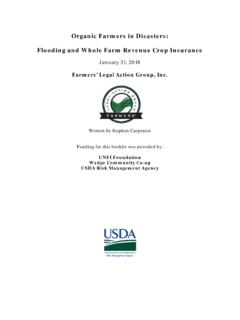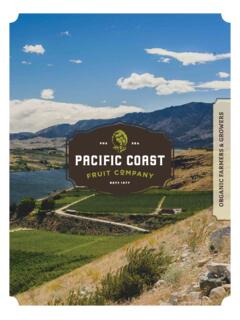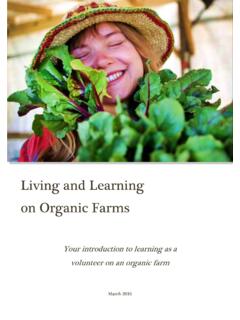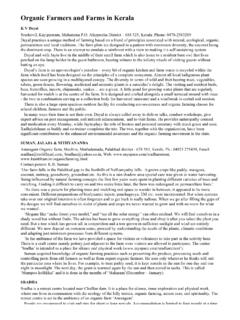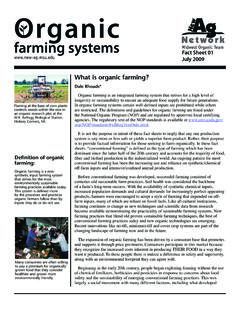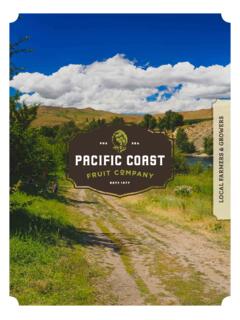Transcription of CROP SEQUENCES FROM EXPERT FARMERS’ FIELDS
1 CHAPTER 4 | Crop SEQUENCES from EXPERT farmers Fields4747 Most experienced organic farmers have a good grasp of the biological principles of crop rotation (see sidebar ). Considering an organic farm field with a healthy, high-yielding crop, the natural question is, what cropping history (or crop rotation) contributed to its vigor and productivity?Chapter 2 (pages 3 20) reviewed the multiple inter-acting factors that experts balance as they manage crop rotations. This chapter presents crop SEQUENCES for ac-tual FIELDS , as implemented by EXPERT organic farmers on their own farms. Twelve EXPERT farmers each recounted the four- or five-year cropping history of one real field on their own farms at a 2002 workshop (see chapter 2, pages 3 20).
2 Cropping SEQUENCES used by four additional EXPERT farmers are also included to better represent the range of crops and farm types in the northeastern US. All of the farms whose field SEQUENCES are presented in this chapter were nominated as exemplary by organic certifiers or other organizations that work with organic farmers . (The farm -ers are described in sidebar , page 48.) The examples in this chapter are illustrations, not recommendations. The farmers emphasized that these sample SEQUENCES may not be (and probably are not) directly transferable to other cropping histories illustrate the use of rules-of-thumb (sidebar , page 55) and the prevalence of crop couplets and short SEQUENCES .
3 The farmers developed these couplets and short SEQUENCES using observation, cumulative knowledge, judgment, and trial and error under real farm , field , and seasonal conditions. Many SEQUENCES continue to evolve as the farms themselves whole- farm requirements of cash flow, mar-ket demands, equipment, and labor availability set the priorities that guided the development of these sequenc-es, the rationale underlying each sequence is based on the needs of each particular field . Another major element in-fluencing each rotation is the total land area that the farm has available for cropping (see sidebar , page 6). Al-though a few SEQUENCES may occur on multiple farms, the market goals and farm logistics guiding them may be dif-ferent in each case.
4 Several farms achieve similar biologi-cal goals with different SEQUENCES of crop families. Reading the Real FIELDS on Real Farms TablesOn the next several pages of tables, the year and season are noted in the left-hand columns, and the sequence of crops is presented in one column for each farm s sample field . These tables are color coded to show each crop s 4 CROP SEQUENCES FROM EXPERT farmers FIELDSSue Ellen JohnsonSidebar of Conventional Rotation Wisdom Avoid planting the same crop family inthe same field too often. Alternate cover crops with cash crops. Alternate deep-rooted crops with shallow,fine-rooted crops. Precede heavy feeders with nitrogen-fixing cover crops.
5 Avoid following a root crop with anotherroot crop.(continued on page 55)This page is from Crop Rotation on organic Farms: A Planning Manual, NRAES 177. To purchase the book, visit , or call (607) 255 7654. The first page of this PDF has information on fair Rotation on organic Farms: A Planning ManualSidebar Farmer Profiles These profiles reflect the status of the farms and farmers in 2002, when the information on the sample SEQUENCES was collected. Of course, farms (and faces) have evolved since the 2002 workshop, but the general character of the SEQUENCES and the farmers remains unchanged: On Four Winds farm in Gardiner, New York, Polly Armour has been growing vegetables with her husband,Jay, on three acres for 15 years.
6 They use the rest of theirland for grazing poultry and cattle. They run a smallCSA and also market to restaurants, wholesalers, and atfarmers markets. In Argyle, New York, Paul Arnold owns PleasantValley farm . For 14 years, he and his wife, Sandy, haveraised vegetable crops on five acres. They market almostexclusively through local farmers markets. The Arnoldshave graciously hosted many organic farming events,including the NEON rotation workshop. David Blyn farms on 12 acres in Roxbury, 13 years, his operation has sold vegetables at farmers markets, wholesale outlets, and through a CSA. Village Acres farm in Miflintown, Pennsylvania, is a 30-acre farm owned by Roy Brubaker.
7 Farming with hisfamily, he has marketed vegetables, berries, and flowersfor 20 years through farmers markets, the TuscaroraOrganic Growers Cooperative, and, more recently,through a CSA. Jean-Paul Courtens farmed 150 acres with 30 acres incash crops in Kinderhook, New York, for 13 years. Heruns a 650-member CSA. In Bridgewater, Maine, Jim Gerritsen has been raisingseed potatoes that are available by mail order andthrough wholesale markets. Wood Prairie farm spans45 acres and has been in business for 26 years. Jimunderstands the challenges of rotation on a farm withonly one important cash crop. Even Star organic farm in Lexington, Maryland, isfarmed by Brett Grohsgal.
8 He cultivates 10 acresand manages 100. A former chef, Brett sells to tenrestaurants, four grocery stores, a university, and at twofarmers markets. Jack Gurley has been farming on five acres in Spark,Maryland, for nine years. His farm , Calvert s Gift farm ,sells vegetables through its CSA to restaurants, atfarmers markets, on the farm , and with other organicgrowers through a cooperative. Kretschmann farm is a 650-member CSA in Rochester,Pennsylvania. Don Kretschmann has been farmingfor 28 years and sells his produce wholesale, as well asrunning the CSA. On One Straw farm in Maryland, Drew Norman hasbeen growing vegetables for 18 years.
9 One hundredacres are in vegetables and another hundred in hay atany given time. One Straw farm supplies vegetables fora CSA, farmers markets, and wholesale outlets. Eero Ruuttila of Nesenkeag farm in Litchfield, NewHampshire, has been growing vegetables on 40 acresfor 16 years. He markets to restaurants, restaurantwholesalers, food banks, and a newly formed multi- farm CSA. Golden Russet farm in Shoreham, Vermont, spans 82acres and has 10 acres in vegetables in any given Stevens has been farming for 21 years and sells hiscrops through a CSA, on- farm sales, farmers markets,food cooperatives, and local restaurants.
10 Anne and Eric Nordell grow vegetables on seven acresof Beech Grove farm in northern Pennsylvania. Forover 22 years, they have relied on horses and their ownlabor to supply several farmers markets. In Penn-Yan, New York, Klaas and Mary-Howell Martens farm approximately 1,200 acres, raising grain,soybeans, and processing vegetables. In addition, theyoperate an organic feed mill and seed processing facilityfor local producers. They began farming organically in1992. John Myer is one of the pioneers of certified organicgrain production in New York. He has been farmingorganically since 1982 and raises soybeans, wheat, spelt,corn, alfalfa, dry beans, and clover seed, along with beefcattle, on 880 acres in Ovid, New York.

